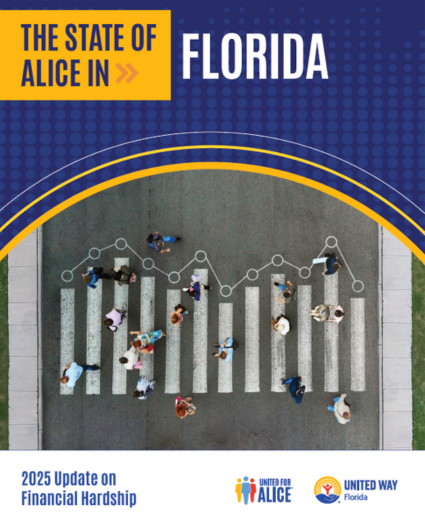Working -- Yet Still Falling Short: 1 in 3 Workers in Florida's Most Common Jobs Struggle to Get By
New research zeroes in on households living paycheck to paycheck, yet often with income that's too high for assistance
 [Gainesville, Fla.] - According to new data from United Way North Central Florida and its research partner United for ALICE, 36% of workers in Florida's 20 most common occupations resided in households unable to afford basic necessities in 2023. These essential workers, who are the backbone of our communities, include cooks, janitors/building cleaners, cashiers, and laborers/movers.
[Gainesville, Fla.] - According to new data from United Way North Central Florida and its research partner United for ALICE, 36% of workers in Florida's 20 most common occupations resided in households unable to afford basic necessities in 2023. These essential workers, who are the backbone of our communities, include cooks, janitors/building cleaners, cashiers, and laborers/movers.
The State of ALICE in Florida illustrates that traditional poverty metrics have significantly underestimated the number of households across the state facing financial difficulties. While 13% of all households in Florida were classified as living in poverty in 2023, the new findings indicate that 34% -- more than double that figure – were ALICE® (Asset Limited, Income Constrained, Employed). Combined, 47% of Florida’s households fell below the ALICE Threshold of Financial Survival, marking a 1% increase from the previous report.
ALICE households earn less than what is required to cover essential expenses such as housing, childcare, food, transportation, healthcare, technology, and taxes. Yet because their income exceeds the Federal Poverty Level, they often do not qualify for assistance.
“When we underestimate the number of households struggling, we also underestimate what it truly takes to build thriving communities,” said Amber Miller, President and CEO of United Way North Central Florida. “This means entire families and essential workers may be overlooked for support, left without the necessary resources to maintain health, achieve financial stability, and realize their full potential. This is a loss not only for ALICE but for all of us.”
The primary challenge for ALICE families is the disparity between wages and expenses. In 2023, a family of four in Florida required $86,688 just to meet their basic needs – nearly three times the Federal Poverty Level of $30,000. Even with both parents working full-time in two of the state’s most common jobs – a personal care aide and a stock worker/order filler – this family’s combined income still fell short of covering essential costs by $20,358.
The State of ALICE in Florida also reveals that in 2023:
- Florida ranked 48th in financial hardship among all 50 states plus the District of Columbia, with one of the nation’s highest percentages of households struggling to make ends meet.
- Some groups face financial hardship at disproportionate rates, with 69% of the youngest and 55% of the oldest households in Florida falling below the ALICE Threshold, compared with 42% of households headed by someone age 25-44.
- Housing continues to be an obstacle for struggling families. Among households below the ALICE Threshold in Florida, 78% of households that rented and 54% of those that owned were rent and housing burdened – meaning they paid 30% or more of their income on rent and housing costs.
In the six-county region served by United Way North Central Florida, many households are facing even greater challenges than the state average. For instance, a family of four with two working adults, an infant and a preschooler in Alachua County needed to earn $92,820 to meet the ALICE Household Survival Budget, while the same family in Dixie County would’ve had to earn $73,476.
2023 ALICE Data
- Alachua County: 19% in poverty, 28% ALICE, totaling 47% below the ALICE Threshold
- Bradford County: 22% in poverty, 29% ALICE, totaling 51% below the ALICE Threshold
- Dixie County: 18% in poverty, 41% ALICE, totaling 59% below the ALICE Threshold
- Gilchrist County: 14% in poverty, 36% ALICE, totaling 50% below the ALICE Threshold
- Levy County: 17% in poverty, 35% ALICE, totaling 52% below the ALICE Threshold
- Union County: 17% in poverty, 26% ALICE, totaling 43% below the ALICE Threshold
“ALICE families are especially vulnerable during natural disasters and times of economic uncertainty and yet often feel unseen or left behind,” said Stephanie Hoopes, Ph.D., National Director at United for ALICE. “By providing a name and a way to quantify these households, we’re equipping communities with the data to build solutions that offer better choices and real pathways to stability.”
More state and local data is available through interactive dashboards on UnitedForALICE.org/Florida.
About United Way North Central Florida
United Way North Central Florida (UWNCFL) is committed to strengthening communities and improving lives across Alachua, Bradford, Dixie, Gilchrist, Levy, and Union counties. Through strategic partnerships and targeted investments, UWNCFL focuses on four impact areas: financial security, healthy community, youth opportunity, and community resiliency. The organization unites individuals, nonprofits, businesses, and government agencies to tackle complex social issues and deliver measurable, lasting impact. Whether through funding local programs, responding to crises, or leading collaborative initiatives, UWNCFL works to ensure that every person in every community it serves has the opportunity to thrive. Learn more at www.unitedwayncfl.org.
About United for ALICE
United for ALICE is a U.S. research organization driving innovation, research and action to improve life across the country for ALICE® (Asset Limited, Income Constrained, Employed) and for all. Through the development of the ALICE measurements, a comprehensive, unbiased picture of financial hardship has emerged. Harnessing this data and research on the mismatch between low-paying jobs and the cost of survival, ALICE partners convene, advocate and collaborate on solutions that promote financial stability at local, state and national levels. This grassroots ALICE movement, led by United Way of Northern New Jersey, has spread to 35 states and the District of Columbia and includes United Ways, corporations, nonprofits and foundations in Alabama, Arkansas, Colorado, Connecticut, Delaware, Florida, Georgia, Hawaii, Idaho, Illinois, Indiana, Iowa, Kansas, Kentucky, Louisiana, Maine, Maryland, Michigan, Minnesota, Mississippi, New Jersey, New Mexico, New York, North Carolina, Ohio, Oklahoma, Oregon, Pennsylvania, South Carolina, Tennessee, Texas, Virginia, Washington, Washington D.C., West Virginia and Wisconsin; we are United for ALICE. For more information, visit: UnitedForALICE.org.
